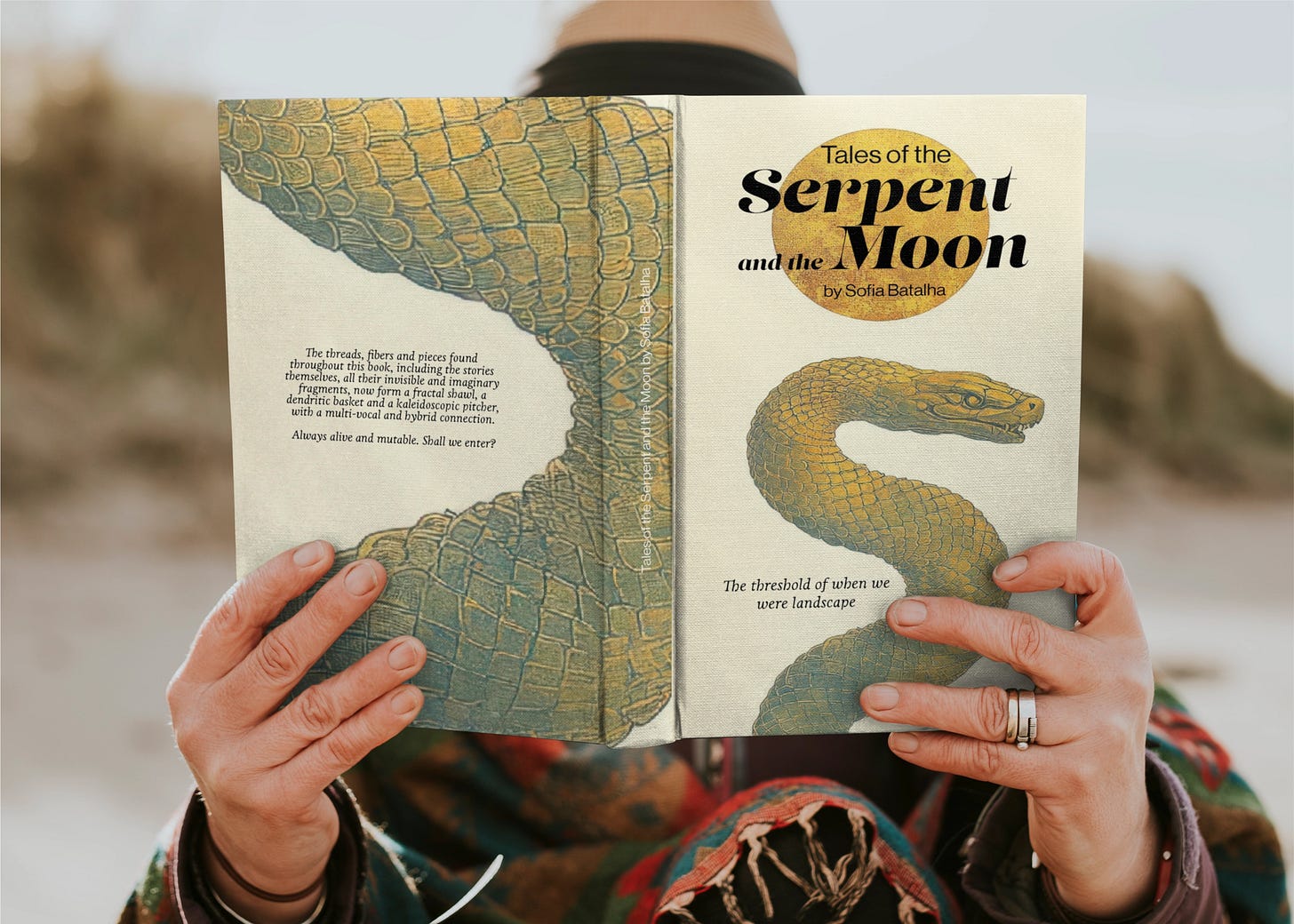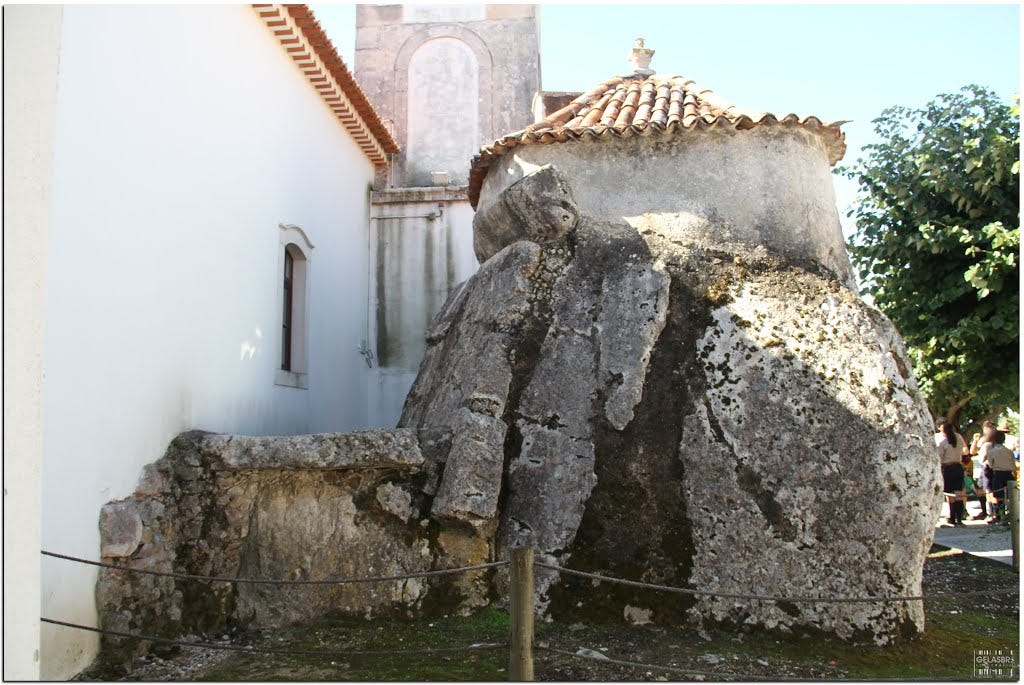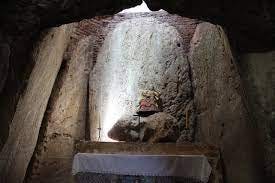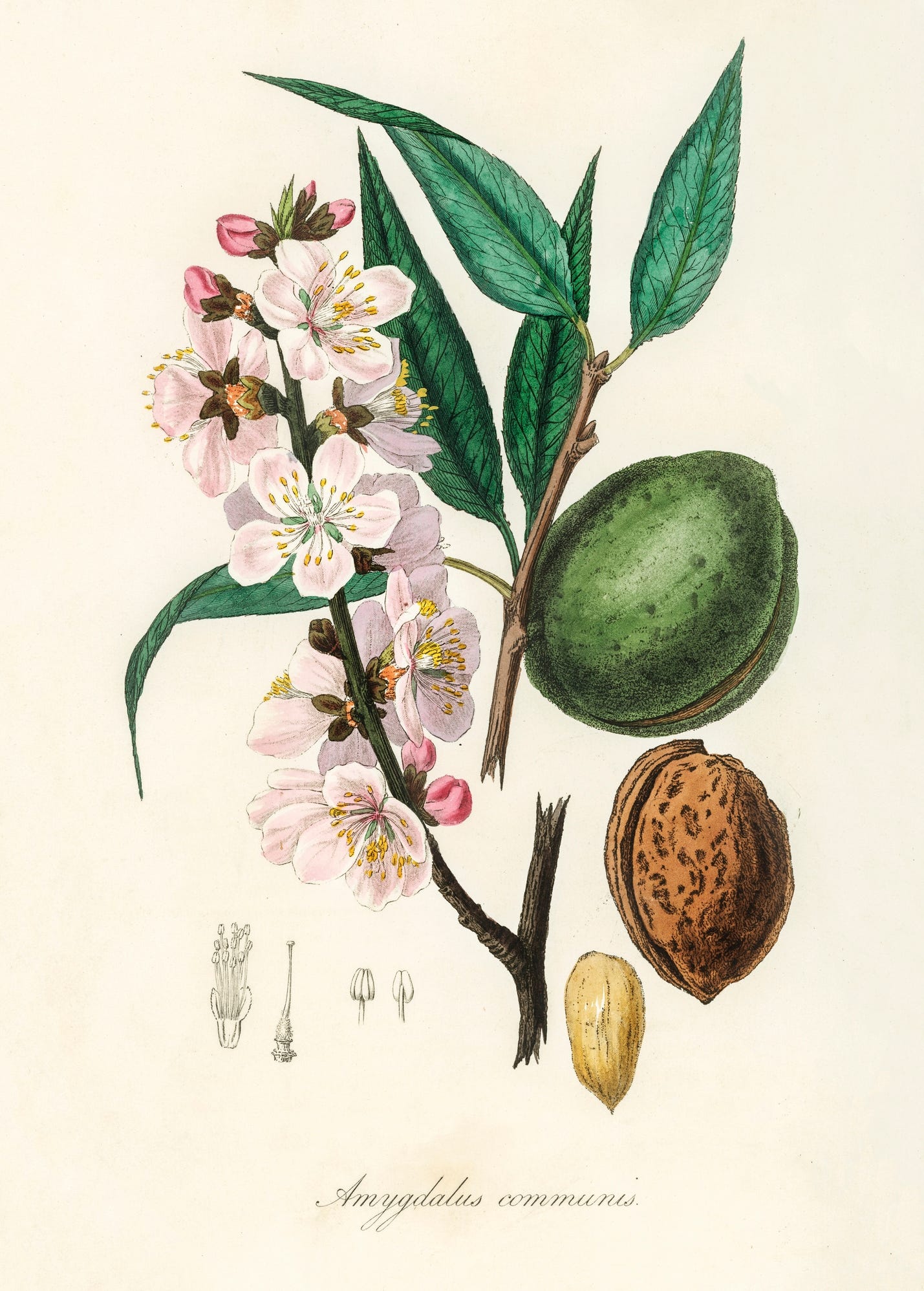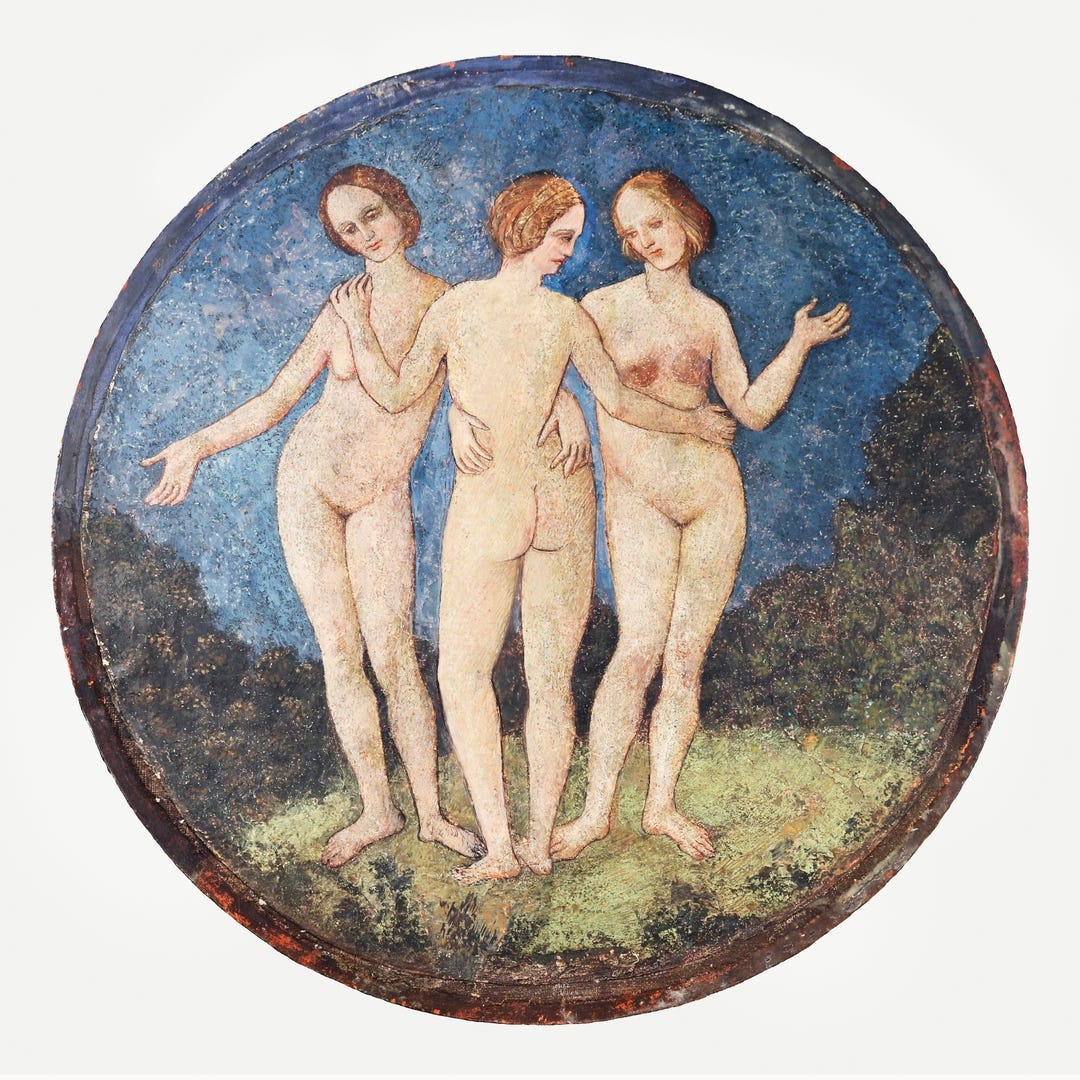Dear reader,
Please note that the content shared here on Substack will differ from what appears in the printed book. While many of the themes, stories, and inquiries may echo across both formats, the book itself has undergone a thorough process of review, editing, refinement, and expansion. In that sense, the printed version holds a more curated, deepened, and embodied iteration of the work.
Think of the Substack as a living ground, where ideas are still fermenting, evolving, and growing their tendrils. The book, meanwhile, is a vessel, harvested with care, ripened in its season, and offered as a more coherent ceremonial bundle.
With tenderness for the ongoingness of becoming,
—Sofia
The Story
Deep back in time, when Stones were still sanctuaries and not strongholds, on the slopes of the Mother Mountains, a young Shepherdess, called Hystera, lived alone with her mother. They lived humbly, with all their worldly possessions being a small hut under an old almond tree, an old pair of scissors, and two brown goats.
Little Hystera had always remembered living there, alone with a Mother of short words and long absences. Even from childhood, she’d learned to look tenderly upon her mother, the woman with lost eyes and a weary heart.
The little Shepherdess liked to see her mother comfortable and well fed, making it a habit to prepare rich broths with herbs, roots, mushrooms and berries she collected from the woods and hills. She learned, from a very young age, to fetch water from the stream and firewood from the forest, and how to kindle a fire. Mother Mountain whispered the right ingredients to her, and her hands delicately and lovingly gathered them, choosing them while she herded the goats. Then she would prepare everything, cutting, macerating, or drying, according to the season and the purpose. At the end of each day, with dedication and attention, she would let the rich mixture simmer in the fire and, when it was ready, she would pour the rich hot broth into her Mother’s bowl. And each day, slowly, her Mother would bring the bowl to her mouth, with her single, trembling hand, and gently blow. As the Mother took the broth, the girl would play her reed flute, and it was in these moments their eyes met, in appreciation and gratitude, and when Hystera felt her Mother was still there, still present. She was so used to taking care of that fragile, mutilated being that was her Mother, that she never even asked about her story, for that elusive gaze was well enough.
Moving slowly, her Mother, with tired bones and a single hand, would always gather three almonds at a time, offered by the Almond Tree by the hut, and laid them to dry, without ever eating them.
Alone, the Shepherdess, with three dried almonds in her pouch and a skin full of fresh water from the brook, would take the two goats herding in the hills every day. In the hard winters, she would take shelter from the cold wind and the unforgiving rain in holes she would dig herself, protected by the surrounding trees and rocks on the mountain slopes. Many a night was spent with her small, slender body wrapped against her two goats on those hard grounds, unable to return home in the cyclopic storms.
But then, one day in the summertime, after much walking up the slopes of the Mother Mountains, absolutely parched, Hystera goes deep into the woods in search of shade, to protect herself from the high noon heat. The cicadas were tumultuously buzzing their hot weather songs.
Among the trees, she finds a silent Stone building, and there she nestles, in the cool air, rocked by the chanting of insects. She takes some water from her skin and eats two of the three almonds she carried. A brokenhearted weariness quickly takes her, and she falls asleep while the goats peacefully graze nearby.
She wakes up in a jolt, not knowing how long she was asleep for, with the sound of a chant in a soft, but deep and sorrowful voice, that makes the Stones and her bones resonate within. It is no longer the cicadas singing. Hystera, utterly curious, peeks through the cracks in the Stones, and sees a beautiful woman, who seems to be weaving while singing her deep lament. The crack between sanctuary Stones she’s chosen to look through at the woman is too narrow, and Hystera struggles to have a better look.
It seems to her that the Woman does, undoes and redoes what she’s weaving, for the thread she’s using was irreversibly cut, ever remaining too short.
Propelled by her eleven-year-old curiosity, she ventures out of the dolmen and looks for the strange figure in her now open field of vision, but there’s nothing there. All she sees is an ochre-coloured snake, that swiftly slithers away overground.
Bewildered, she re-enters the Stone sanctuary, peering once again through the cracks and seeing the Woman moaning her longing as she weaves a strange, amputated thread, apparently made of gold. The Woman turns suddenly and her sorrowful eyes meet Hystera’s, looking directly into her Soul. Her gaze is familiar and mysterious at the same time. One side of the Woman's face is fair, while the other is disfigured by a huge, pulsating red scar that tears her face from forehead to chin. In the blink of an eye she disappears, leaving behind an empty silence.
The Shepherd girl is left in a mix of fascination and fear, rooted to the ground. Slowly, the cicadas resume their singing. Gradually, Hystera collects herself and hurriedly gets up to leave, calling her two goats on her way back home. Running fast, down the Mountains and back to the hut, she comes across a small black goat, wandering around, lost. Despite being very hungry and surprised herself, she could never leave the little goat there all alone. Lovingly, she offers it the last almond in the pouch, calling to her. The little goat walks cautiously in her direction and eagerly takes the almond, a sisterly welcome into that odd, fugitive flock stumbling down the hill.
Days and months go by and Hystera cannot take the Woman out of her mind. She spoke nothing of her strange encounter to her Mother, but she repeatedly hears the lament in her dreams and has nightmares about the scar swallowing her whole in one go. The little black goat, in the meantime, has settled into the herd and found a new nestling place in the Mother’s bony lap, who with her single hand now had three tasks: to gather three almonds and set them to dry; to drink her broth; and to pet the little goat.
A year went by before the Shepherdess finally gathered enough courage to return to the Mountain and meet the Woman once again. At daybreak on that day, her Mother, in a brief moment out of her exile, whispers faintly to Hystera: “don’t be long.” Despite her astonishment at this never-before spoken advice, Hystera hurries back to the Shrine of the Stones, alone, with three dried almonds in her pouch, a flute in her hand, and fresh water inside her skin, taking the now three goats up to the mountain anew.
After the steep climb and entering the woods, she nestles her still slender body into the dolmen stone and waits. During that time, she eats one of the three almonds and, unaware of how much time has passed, unaware whether she fell asleep or not, she once again hears the strange ancient lamentation that makes the Stones resonate on the inside, that howl which chased her in dreams all throughout the year that had passed.
Boldly, she takes up her flute and blows breath through it, playing the melody back to the enchanted song. Out there, the Woman softly becomes aware of the girl’s presence and both melodies - the voice from the depths of time and the reed pipe - weave and combine into each other. The Shepherdess begins to feel the strange attunement radiate through her body and, all of a sudden, sounds turn into words and images, and she can see and hear the story the song is telling, spoken deep within her bones.
The mysterious Woman, weaving with a single gold thread, stone and linen, mourns her tragic estrangement from her sisters. She winds and weaves the thread of longing through the loom again and again, and with each loop, Hystera learns another piece of the story being sung.
~~~~~
They were three sisters, daughters of primeval Night and the Mountain Stones. They lived, all three, together, since the beginning of time in the sanctuary where the Shepherdess now huddled. A Sister who weaves, a Sister who pulls and spools the thread, and a Sister who cuts it with her magic scissors.
However, sixty-four seasons ago, that had changed, for the Sister who cut the thread fell hopelessly in love with a man, a hunter both young and sweet, who loved her back with every heartbeat. For his sake, she suffered, and in a tragic moment of tearing love, in the urge to become a warm, pulsating body and living her love in full, she severed the thread - the Thread of Life, made of gold, stone and linen, which connected her umbilically to her sisters. That cut, however, did not suffice, for merely touching it made the living thread heal at once.
Desperate, she severed further, cutting her own hand in howling pain. The Weaver sister tries to stop her and prevent her agony, but amidst the Cutter sister's spasms of pain at her self-mutilation with the sacred scissors, a thrust in the air brings the sharp edge directly to the Weaver’s face, sending her reeling also in pain.
After that terrible night, the sisters were torn apart. The Sister who spooled the Thread of Life, having witnessed such violence, was engulfed by deepest sorrow, and every skein of thread she pulled and wound would become a handful of coarse, thick black hair. Eventually, she forgot who she was and became a goat, with hooves for hands and horns on her head, wandering aimlessly through the forest. The Weaver sister, despite her cleft face, continued to weave with the severed thread, wailing her pain, in the vain hope of finding her sisters. The Cutter sister, now one-handed and her scissors bereft of magic, ran away in tears and torment, nestling in the arms of her brief but true love, who received her open-heartedly.
They had become lost to one another, and all that was left was memory and longing.
~~~~~
As suddenly as it had begun, the mysterious encounter ended, the melody ceased, but now Hystera knew what she had to do. She left one of the two almonds on top of the Stone Sanctuary and flew down the mountain all the way to the hut, chased closely by her three goats.
When she arrived, she found her Mother sitting under the Almond tree in full bloom. At her feet, the scissors, no longer rusty, but rather shining like gold in the sunlight. Gasping with exhaustion, the girl and her goats surround the Mother, who reaches out her stump for her daughter to kiss. In all tenderness and care, Hystera places thereupon a heartfelt kiss and offers her last almond to her Mother. She takes it and without a moment’s pause, her hand begins regrowing, in a cloud of golden light and dust.
The little black goat returns to her woman’s form and, to the Shepherdess’ astonishment and awe, what was black goat’s hair is now yarn after yarn of enchanted thread, that stretches out, branching and expanding up the mountain slope as if by magic, wrapping around the Weaver sister and pulling her back toward her sisters, her face restored and freed from the terrible scar.
The three women embrace one another in mutual recognition and encircle Hystera into their loving fold..
“Only you could undo our terrible curse, my child”, her Mother whispers, two-handed once more and a new light in her eyes. The three sisters, now reunited, weave a special shawl for the Shepherd girl, in thanks for her courage and kindness. A shawl woven by the daughters of primeval Night and the Mountain Stones, made of living thread in gold, stone, and linen. The Magic Shawl. "Whenever you need me, daughter, run the shawl over the stones and I will come to your aid. Always."
After the story, please take some time to feel how it relates to you and what unfolds and resonates with your unique context.
Let's breathe.
What breathes through the tale
What follows is not a symbolic interpretation of the tale, exiling it in a single narrative. There is a unique symbiotic dialogue with its living layers that is yours to feel, sense, and travel through. The following words are mythical, historical, and place transcontextual information that resonates with the tale pulsing realm.
This tale wasn't dreamed, but rather imagined, and I then looked for echoes from where I had unconsciously weaved it, and many relationship threads emerged.
Aire and Candeeiros Mountains
This story was woven during the hot summer nights, and the sentient and alive Mother Mountains accompanying the shepherdess are the Aire and Candeeiros Mountains (PT - Serra D’aire e Candeeiros), with their ancient structure, either geologically or ecologically, and inhabited for millennia.
The dolmen in the story is the Chapel Dolmen that is attached to the main church in the village of Alcobertas, dating between four thousand and three thousand five hundred years BC. This Chapel Dolmen is mysteriously dedicated to Saint Ana, mother of Mary, the wise grandmother-mother who imparts experiential wisdom heart to heart, and she herself also magically fertilised/impregnated. The echo between Saint Ana (Ana is the name of very ancient goddesses related to water) and the Serra Matriz is deep and ancient: the memory of this place as a primordial Mother, as a Matrix, she who conceives, sustains, supports, and cares, heart-to-heart, soul to soul. Its various subterranean landscapes, the caves and caverns of this limestone landscape, are the womb of this matrix-mother, expanding and contracting with each lunation.
Hystera
The Shepherdess's name, Hystera, literally means “womb'' in ancient Greek, and it’s a word that’s been stripped of its power and sovereignty, originating the concept of "hysteric," which means exaggerated or uncontrollable emotion or excitement. This is an oppressive and negatively perceived expression related to uncontrolled female behaviour or emotional exaggeration. The empowerment during the Shepherdess's metamorphosis throughout this tale rescues some of her lost dignity in a very simple way.
Almond tree
In this tale, the presence of the Almond tree is also a metaphor for reuniting and providing sacred food. There are countless myths and stories generated around magical trees; for example, in one of its oldest versions, the original Cinderella tale centred around a hazel tree. The Almond tree is part of the rose family but resembles the peach tree. Its white flowers are slightly larger than peach blossoms and grow in groups of no more than three. It has been cultivated throughout the Mediterranean for over 5,000 years, and its wild presence predates it, as it is one of the oldest known nut-bearing trees. Trade Mediterranean routes between Greeks, Romans and Egyptians carried almonds along with the stories, myths and legends of the tree. Being the first flower to bloom after the winter solstice in the Northern Hemisphere, it conveys awakening but also sweetness, charm, and delicateness.
Handless Maiden
Another partial influence on this story is the Handless Maiden tale. In this tale, a miller's daughter loses her hands due to a bad deal her father made with an evil entity (with later references to the devil). The girl then leaves home and goes through the forest for seven years, eventually finding pears, a fruit symbolic of feminine strength, in the garden of a tender-hearted king. The king falls in love with and marries her, giving her two new hands made of silver, which she never uses. The young woman gives birth to a son, but the king is off at war and the devil interferes once again (or the malicious mother-in-law), deceiving the court. She flees back into the forest with her son and her own hands grow back. In the version by the Brothers Grimm, her hands grow because she has been good for seven years, but a Russian version, where the maiden drops her child into a fountain while bending over to drink, is different: she dips her handless arms into the water to save the child and that's when her hands grow1. In an interpretation by Marie Louise von Franz in her book, “The Feminine in Fairytales,” she argues that the story reflects how women cut off their own hands to live through men. They must go into the forest, into nature, to live alone, regaining their power. The child represents a woman’s creativity, which only she can rescue and who, in return, will be rescued by it.
There is also the Iberian Almoravid Morisco tale of the Handless Maiden from the Iberian Peninsula, Carcayona or Arcayona, a myth about a faithful woman vilified by her father. A tale about faith, identity, and resistance, carrying a metaphor for both power and powerlessness. The story of Carcayona reads as a Muslim version of the Handless Maiden tale.2
Goat
The story again presents us with the Goat, often equivalent to the Deer, more commonly involved in fairy tales. Goats are often related to the discovery of psychoactive plants and the subsequent revelations, due to their habit of grazing on everything. The milk and meat of both animals that graze on magical plants and honey bees can be psychoactive, transporting us between worlds, helping to perceive other entities and dimensions, and reclaiming sacred wisdom.
Sisters of Destiny
Lastly, the ancestral pattern of the three Sisters of Destiny, the fairies of fate, is explored in detail under the theme of the Spinning Mouras (PT: Mouras Fiandeiras), in following articles.
Why are these tales important now?
INTRO, tale list and chapter references.
THE TALES
The Goat Girl - Belinda & Benilde & What breathes through the Tale
The Shepherdess - Hystera and the thread of life & What breathes through the Tale
The Red Cloak - Ananta the She-Wolf Woman & What breathes through the Tale
Lucífera and the Cauldron - The Cinder Girl & What breathes through the Tale
Carisa - The First Wailer & What breathes through the Tale
Monster Sanctuary - Brufe and the Bears & What breathes through the Tale
Queen of the West Sea - Oki-usa and the Black Rock & What breathes through the Tale
FOLLOWING CHAPTERS
Remembering the Tales / Disappointed Moors - The Disenchantment of Growing up Storyless, Part I
Disappointed Moors - The Disenchantment of Growing up Storyless, part II
Washing Moors - Washing History, part I
Washing Moors - Washing History, part II
Builder Mouras - Mythical Territory
Warrior Mouras - Guarding and Protecting the Sacred - Part I
Warrior Mouras - Guarding and Protecting the Sacred - Part 2
Enchanted Mouras - The Power of Imagination
Spinning Mouras - Telling and Weaving the Stories
From the Book - Contos da Serpente e da Lua, Sofia Batalha(in portuguese)
Tomanek, Jeanie, and Terri Windling. “Myth & Moor: Wild Sanctuary and The Handless Maiden.” Terri Windling, 1 February 2018, https://www.terriwindling.com/blog/2018/02/handless-maiden.html.
The Handless Maiden: Moriscos and the Politics of Religion in Early Modern Spain, Mary Elizabeth Perry.





